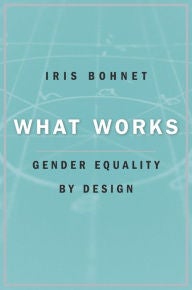 Iris Bohnet, author of What Works: Gender Equality by Design, believes that much more can be done to address gender inequality in the workplace. Bohnet, a professor and the director of the Women and Public Policy Program at Harvard Kennedy School, joined us on the Knowledge at Wharton show on Wharton Business Radio on SiriusXM channel 111 to talk about the importance of data in addressing bias and ways to design for change.
Iris Bohnet, author of What Works: Gender Equality by Design, believes that much more can be done to address gender inequality in the workplace. Bohnet, a professor and the director of the Women and Public Policy Program at Harvard Kennedy School, joined us on the Knowledge at Wharton show on Wharton Business Radio on SiriusXM channel 111 to talk about the importance of data in addressing bias and ways to design for change.
An edited transcript of the conversation follows.
Knowledge at Wharton: How much better is the workplace now, compared to 20 years ago?
Bohnet: It is better, although not that much better…. Some organizations have made a lot of progress at the entry level … in that we now have 50/50 splits at the entry level in many consultancies and many law firms, and in many different places, [such as] universities. We’ve made a lot of progress there. We haven’t really closed the gap in leadership though.
Knowledge at Wharton: You talk about the fact that gender equality in the workplace is not only a business imperative, but it’s a moral imperative as well. Can you expand on that a little bit?
Bohnet: One of the most impressive research pieces that speaks to this question of the moral imperative, in fact, comes out of the Wharton School by Rob Jensen, who is a professor [of business economics and public policy] there. What he was trying to understand was “gendercide.” What gendercide means is the selective abortion, killing and neglect of girls in many parts of the world, and that obviously, is a hugely moral imperative.
“There are a number of companies providing tools that allow companies to … blind themselves to [job candidates’] demographic characteristics.”
The U.N. [United Nations] now estimates that about 20 million women and girls are missing. I tell the story because it actually has a happy ending. Rob was trying to understand whether creating economic opportunities could affect the survival rates of these women and girls…. He went into India and worked with call centers, [which] moved into India in the 1990s. He offered training programs for women to go and work in these call centers…. He was measuring whether these increased opportunities affected how parents treated their daughters. That’s exactly what he found. Return on investment is obviously a business concept. But return on investment matters, even for the poorest of the poor, and can affect survival rates of women and girls.
Knowledge at Wharton: We were just speaking with Sharon Ritchey, who is the current COO of AXA Financial. One of the initiatives they have tried to push forward is looking at the paths of women, given that women do live longer. They are still making less. They need to be prepared financially, in terms of retirement, for a longer life afterward. We take for granted, at some point, that this is an issue within the United States. But we forget that a lot of these issues are multiplied when you’re talking about other countries.
Bohnet: That’s exactly right. We’ve made a lot of progress in this country, certainly, and also created some interventions. Let me give you one that has nothing to do with what we’ve just described, but I do think will resonate. American symphony orchestras … felt that maybe they weren’t completely objective in their evaluations of musicians. So, they had them audition behind screens. To their surprise, it increased the likelihood that women musicians would advance to future rounds by 50%. In the 1970s, we had about 5% female musicians in our major symphony orchestras. Now, there are almost 40%. The screen is a simple design intervention that started here in this country, and that still has not spread to many other orchestras around the world.
Knowledge at Wharton: Bias is a thing that you would like to see eliminated, but it has been so ingrained in our people, our cultures. I’m a little concerned that maybe we’re not able to do enough about it going forward. Is that also a concern of you?
Bohnet: It absolutely is a concern of mine. You are right in suspecting that our minds are stubborn beasts. It is, in fact, hard to change mindsets. Therefore, I am suggesting a somewhat different approach, which goes beyond diversity training, beyond trying to fix our minds, [to] really try to fix our organizations.
Knowledge at Wharton: If you’re looking for the most qualified candidates, maybe the resumes need to have the names taken out of them so decisions are made based on what people have accomplished.
Bohnet: A number of companies, in fact, do this very same thing. There’s now software out there. One is called Unitive. Another one is called GapJumpers. A third one is called Applied. There are a number of companies providing tools that allow companies to do this in a relatively simple and straightforward way and blind themselves to demographic characteristics, or anything else that they would like to blind themselves to — at least, in initial rounds of evaluations.
Knowledge at Wharton: If you look at the workplace in general, what do you think are some of the better ways to try to eliminate bias?
Bohnet: Every good analysis starts with data. Of course, I am biased, given that I am a scientist. But I do think that’s also very sound advice for any organization. Don’t just throw money at the problem and run a diversity program or a leadership program or any program. This is someone saying that who is in the business of training people. But don’t just throw money at the problem. Try to understand what, exactly, is broken.
Big data is really going to revolutionize our HR departments because we will be able to understand who in our company, for example, and who is more likely to still be here in a couple of years from now…. It also plays an important role in understanding bias. A number of companies, for example, have found something that is now called performance-support bias. It actually started with stockbrokers, interestingly enough. It’s an interesting study because a stock brokerage, of all places, is an environment where you can measure performance relatively accurately. The fear was that women weren’t performing as well as their male counterparts. When they actually looked and counted, they found that women were given worse-performing accounts to start with. That, of course, then affected their performance. If they hadn’t measured, they wouldn’t have known. Measurement really is the first place to look.
“Don’t just throw money at the problem and run a diversity program or a leadership program.”
Knowledge at Wharton: How do you think the importance of data is going to affect gender equality issue going forward?
Bohnet: Data have always played an important role and do allow us to make more objective decisions, rather than trust our gut instinct, which sadly, leads us astray. What has changed now is what we do with the data. Yes, we collect more, and yes, we have better instruments to collect more. In particular, we have tools such as machine learning, which allow us to analyze data in a way that we haven’t been able to do before. Yes, they will absolutely change the playing field as well, because we will not have to trust our gut instincts anymore when we evaluate somebody, but can in fact, use work sample tests, for example. And use more objective measures, and have data to analyze them.
Knowledge at Wharton: Do you think that that a level playing field is a realistic possibility at some point down the road?
Bohnet: I am an optimist, so yes. I actually do believe it is a possibility out there. Instead of just dressing the wound or hiding the wound, we really have to get at the source of what’s going on — Again, data is going to be informative to understand what’s broken in our organizations. Is it at the hiring level? Is it at the promotional level, for example, where we find lots of bias — and then, intervene?
Knowledge at Wharton: You use the word “design” in an acronym to lay out this whole process.
Bohnet: The D stands for data, and we’ve talked about the importance of data collection before. E stands for experimentation. I point that out in particular to businesses because businesses often are too quick to just adopt a new fad or try something out and roll it out wholesale. One of my big messages is for businesses also to be a bit more humble and pilot something. Do A/B testing not just in your marketing departments, but also for example, in HR. Experimentation is important just to see whether something works. Then finally, the sign in design is the signpost.
The metaphor that I use in book and that might also resonate with some of our listeners is that many of us have been in hotel rooms where we were given a room key card that turns the light on and off automatically when you put it in and take it out again. Now, that turns out to be a super clever, very cheap design invention that makes it so much more likely that the light is off, than any flyer that well-meaning hotel staff could leave on our bed, saying, “Please turn off the light. Please conserve energy. Please reuse the towels.” The room key card is a bit of a signpost. It makes it very easy for us, in our biased minds, to do the right thing. That in many ways is the most important message of the book: This is not about bad people doing bad things. This is about all of us falling prey to these biases because we all see the world the way it is. We don’t see many male kindergarten teachers, and we don’t see many female CEOs. Therefore, we don’t naturally associate those jobs with men or women, respectively.
Knowledge at Wharton: There obviously has been a sea change, in terms of the number of women at the C-suite level over the last decade. You get the sense that we will see more women executives going on over the next 10 years. Correct?
Bohnet: That is certainly the expectation. The question is how fast the needle will move. Recent projections that I’ve seen on the World Economic Forum suggest that this is going to be more of a hundred-year timeframe until we have actually achieved gender equality….
“Big data … plays an important role in understanding bias.”
Knowledge at Wharton: You also talk in the book about the importance of role models for women right now.
Bohnet: Role models for anyone, not just for women. In fact, let me start with boys first. Very important evidence came out of the OECD [Organisation for Economic Cooperation and Development] last year, showing that our 15-year-old boys now lag by about a year in reading and writing, compared to our girls. One of the reasons is the lack of male role models, of male teachers — in particular, male teachers in English or in other reading and writing related subjects. The evidence suggests to us that role models [are important] across the board — of course, also for girls. For example, one study has shown that when girls were given female role models to look at before giving a speech, they objectively would give a more powerful speech afterward.
Knowledge at Wharton: What do you see in this area when you’re talking about young girls? That’s a very important part to this puzzle. You have to start to influence girls at a young age.
Bohnet: There is a very ingenious design intervention going on. That is the new SAT. The SAT … is going to be gender de-biased. A fraction of the SAT is a multiple-choice questionnaire, which comes with five possible answers. The old SAT had a point associated with getting an answer right and a quarter-point deduction for a wrong answer. What that means is that those of us more willing to take risk would be more willing to guess. And those of us less willing to take risk, or being risk averse even, are more likely to skip questions.
A student of mine, Katie Baldiga Coffman, who is now a professor, wrote her dissertation on this very topic and measured whether this affects performance of girls and boys on the SAT. She found that indeed, it was true that the girls were less willing to guess and more likely to skip questions. Controlling for how much they would have known, that costs them dearly on the SAT. So, we lucked out. The College Board decided to redesign the SAT, lots of different design elements. But one of them, in fact, is to take out the penalty from wrong answers to level the playing field for people, independent of their willingness to take risks. After all, the test was not designed to measure risk-taking.


